The
rise
and fall of rotary engines
Felix
Wankel originated the idea of rotary engine as early as 1920s but
development
started as late as 1954 when he persuaded NSU, a motorcycle
manufacturer then,
to fund the project.
In
theory, the rotary engine has a lot of fascinating advantages. Firstly,
the rotors spin in one direction, unlike piston which changes direction
reciprocately, thus it should be smoother and waste less energy.
Secondly, it
uses less components - a twin-rotor Wankel engine equals to
a conventional
6-cylinder engine, and it had no valve gears, crankshaft or connecting
rods, thus it could be smaller, lighter and simpler than piston
engines.
Thirdly,
lack of valve gears and crankshaft leads to less vibration and
noise.
NSU's
rotary
engines
Dr.
Wankel experimented his first rotary engine in NSU, which eliminated
the
imperfect eccentric movement of rotor by a revolving housing which was
held by another housing. It was perfectly smooth, but too complicated
to
implement in economical way. Therefore at last a more compromised
design,
with an eccentric rotor and a single fixed housing (that is the one
Mazda
still using today) was adopted.
The
first production rotary car was the 1963 NSU Spyder, a small car like
Fiat
850 Spyder. It had single rotor with capacity of 498 cc. That was
just
a low volume experimental project.
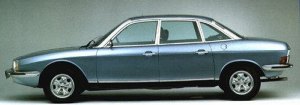 The
really ambitious application came in 1967 when NSU
launched
the famous Ro80 mid-size sedan, which won European Car Of The Year that
year. Two rotors produced 115 smooth horsepower. Unfortunately, it was
quickly found to be unreliable.
Tip sealing worn out quickly, increasing fuel consumption, decreasing
power
and even leaking oil. This cost NSU a lot for repair and established
a poor
reputation for Wankel engines. To a certain extent, NSU’s bankruptcy
and
absorption by the Volkswagen group was due to the Wankel engine. Since
then it
had never
produced rotary engine again. The
really ambitious application came in 1967 when NSU
launched
the famous Ro80 mid-size sedan, which won European Car Of The Year that
year. Two rotors produced 115 smooth horsepower. Unfortunately, it was
quickly found to be unreliable.
Tip sealing worn out quickly, increasing fuel consumption, decreasing
power
and even leaking oil. This cost NSU a lot for repair and established
a poor
reputation for Wankel engines. To a certain extent, NSU’s bankruptcy
and
absorption by the Volkswagen group was due to the Wankel engine. Since
then it
had never
produced rotary engine again.
However,
before that happened Wankel engines had already attracted much
attention globally. To raise development
budget, NSU sold the license for United States to an aircraft engine
maker
called Curtiss-Wright, which then sub-licensed to General Motors, Ford
and other car makers.
GM's
effort
General
Motors was the most eager player besides NSU and Mazda. It obtained
worldwide
license from NSU in 1970, then displayed two prototypes in 1973,
Chevrolet
Corvette 2-Rotor and Corvette 4-Rotor, both were mid-engined sports
cars. Having
invested
a lot of money on rotary projects, GM planned for 80% of its 1980
production
to be rotary cars.
The
real production car, Chevrolet Monza, was to be launched in 1974, but
the
plan was hit by the newly announced smog regulations for 1977, which
was
so strict that GM feared the rotary engine might not pass. Eventually,
Monza appeared with conventional engines. The prospect of rotary
programme
became uncertain, and virtually dead when its supporter, Ed Cole,
president
of GM, retired in September 1974.
Citroen,
Mercedes and Nissan
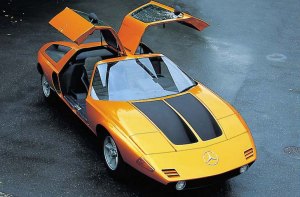 Citroen
collaborated with NSU and created 2 rotary cars, Ami 6 M35 and GS
Birotor.
Both were powered by NSU engines. However, they were short-lived and
limited
in number. Citroen
collaborated with NSU and created 2 rotary cars, Ami 6 M35 and GS
Birotor.
Both were powered by NSU engines. However, they were short-lived and
limited
in number.
Mercedes
was another giant European car maker to experiment Wankel engines.
Mid-engined
exotic concept car C111 stunned the world in the 1969 Frankfurt motor
show.
3 rotors and 4 rotors version produced 320 hp and 405 hp respectively.
But
it did not come true.
Nissan
took a Wankel license in 1970 and created a prototype in 1972. It
planned
to produce a small sports car at the rate of 120,000 cars per year, but
eventually cancelled after the 1973 oil crisis.
Mazda
-
the only survivor
Mazda,
called Toyo Kogyo then, obtained the license from NSU in 1960.
Originally
it wanted to put NSU's engine directly to its vehicle, but after
experienced
delivery delay and disappointing vibration and fuel consumption, it
designed
its own version started from drawing board.
Why
was Mazda so eager to develop this technology ? Because in the 1960s,
the
Japanese government wanted to merge various car makers in order to
enhance
their global competitiveness. To retain independence, Mazda believed
developing
a unique technology would help. Therefore the decision to develop
Wankel
engine was not because of profit.
Its
first rotary car, Cosmo, went into low volume production in 1967. That
was a 2-seater GT like the original Ford Thunderbird. Twin-rotor each
displaced
491 cc, capable of pumping out 110 hp. It
was
a true 200 km/h GT. 5 years of production totalled 1,519 units.
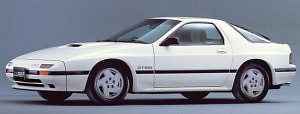 Having
experimented, Mazda became confident to put Wankel engines into mass
production.
In 1968, it launched a 4-seat coupe called R100, which was based on the
mass-produced Familia sedan. Powered by 10A twin-rotor engine with 100
hp output. It was shipped to the USA in 1970 and became a hit. Mazda
created a
rotary boom there with more rotary cars followed - R130, RX-2 and RX-3,
all
were based on the R100. In 1971, Mazda produced the 200,000th rotary
cars. Having
experimented, Mazda became confident to put Wankel engines into mass
production.
In 1968, it launched a 4-seat coupe called R100, which was based on the
mass-produced Familia sedan. Powered by 10A twin-rotor engine with 100
hp output. It was shipped to the USA in 1970 and became a hit. Mazda
created a
rotary boom there with more rotary cars followed - R130, RX-2 and RX-3,
all
were based on the R100. In 1971, Mazda produced the 200,000th rotary
cars.
The
prospect was bright, and the company planned to produce 100% rotary
cars by 1975. But the oil crisis changed that in one night. Since
rotary
cars
were well known for thirsty, sales in the US was down by half in 1974
and
did not recover to the 1973 level until RX-7 was launched. Wankel
engine
for econo cars became out of the plan, thus limited to only RX-7 in the
following 20 years. The only exception was the 1992 Cosmo, which was a
modernised version of the original Cosmo, with 280 hp twin-turbo
3-rotor
Wankel, though it sales was bounded in Japan.
RX-8 and RENESIS
For
30 years, countless of car makers tried to develop Wankel engine but
they
eventually gave up. The only survivor, Mazda, made the most progress
but
still failed to catch up with the progress of piston engines. The
biggest
weaknesses of Wankel engines have always been heavy fuel consumption
and
poorer
emission, the latter eventually killed RX-7 in 2002.
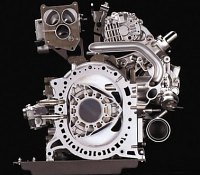 Just
when everybody saw Wankel engine falling, Mazda worked quietly on a new
generation Wankel engine called RENESIS (means Rotary Engine Genesis),
which eventually applied to the RX-8 coupe. RENESIS differed from all
the
previous Wankel engines in exhaust ports configuration - the old ones
used
side intake ports and peripheral exhaust ports, but the new engine had
side ports for both intake and exhaust. This eliminated overlap between
intake and exhaust period, lengthened expansion
stroke and enhanced thermal efficiency. It also improved breathing
efficiency and reduced pollution, enabling the RX-8 to comply with
tighter emission regulations. Just
when everybody saw Wankel engine falling, Mazda worked quietly on a new
generation Wankel engine called RENESIS (means Rotary Engine Genesis),
which eventually applied to the RX-8 coupe. RENESIS differed from all
the
previous Wankel engines in exhaust ports configuration - the old ones
used
side intake ports and peripheral exhaust ports, but the new engine had
side ports for both intake and exhaust. This eliminated overlap between
intake and exhaust period, lengthened expansion
stroke and enhanced thermal efficiency. It also improved breathing
efficiency and reduced pollution, enabling the RX-8 to comply with
tighter emission regulations.
However, the RENESIS was still too thirsty compared with conventional
piston engines, especially when the development trend headed towards
greenness in the late 2000s. Can Mazda's Wankel engines make another
breakthrough ? It will be interesting to see.
|
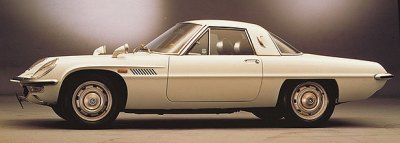
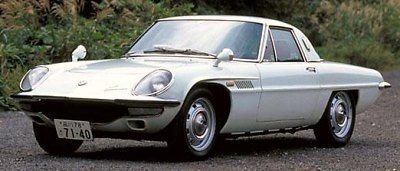
 The
really ambitious application came in 1967 when NSU
launched
the famous Ro80 mid-size sedan, which won European Car Of The Year that
year. Two rotors produced 115 smooth horsepower. Unfortunately, it was
quickly found to be unreliable.
Tip sealing worn out quickly, increasing fuel consumption, decreasing
power
and even leaking oil. This cost NSU a lot for repair and established
a poor
reputation for Wankel engines. To a certain extent, NSU’s bankruptcy
and
absorption by the Volkswagen group was due to the Wankel engine. Since
then it
had never
produced rotary engine again.
The
really ambitious application came in 1967 when NSU
launched
the famous Ro80 mid-size sedan, which won European Car Of The Year that
year. Two rotors produced 115 smooth horsepower. Unfortunately, it was
quickly found to be unreliable.
Tip sealing worn out quickly, increasing fuel consumption, decreasing
power
and even leaking oil. This cost NSU a lot for repair and established
a poor
reputation for Wankel engines. To a certain extent, NSU’s bankruptcy
and
absorption by the Volkswagen group was due to the Wankel engine. Since
then it
had never
produced rotary engine again. Citroen
collaborated with NSU and created 2 rotary cars, Ami 6 M35 and GS
Birotor.
Both were powered by NSU engines. However, they were short-lived and
limited
in number.
Citroen
collaborated with NSU and created 2 rotary cars, Ami 6 M35 and GS
Birotor.
Both were powered by NSU engines. However, they were short-lived and
limited
in number. Having
experimented, Mazda became confident to put Wankel engines into mass
production.
In 1968, it launched a 4-seat coupe called R100, which was based on the
mass-produced Familia sedan. Powered by 10A twin-rotor engine with 100
hp output. It was shipped to the USA in 1970 and became a hit. Mazda
created a
rotary boom there with more rotary cars followed - R130, RX-2 and RX-3,
all
were based on the R100. In 1971, Mazda produced the 200,000th rotary
cars.
Having
experimented, Mazda became confident to put Wankel engines into mass
production.
In 1968, it launched a 4-seat coupe called R100, which was based on the
mass-produced Familia sedan. Powered by 10A twin-rotor engine with 100
hp output. It was shipped to the USA in 1970 and became a hit. Mazda
created a
rotary boom there with more rotary cars followed - R130, RX-2 and RX-3,
all
were based on the R100. In 1971, Mazda produced the 200,000th rotary
cars. Just
when everybody saw Wankel engine falling, Mazda worked quietly on a new
generation Wankel engine called RENESIS (means Rotary Engine Genesis),
which eventually applied to the RX-8 coupe. RENESIS differed from all
the
previous Wankel engines in exhaust ports configuration - the old ones
used
side intake ports and peripheral exhaust ports, but the new engine had
side ports for both intake and exhaust. This eliminated overlap between
intake and exhaust period, lengthened expansion
stroke and enhanced thermal efficiency. It also improved breathing
efficiency and reduced pollution, enabling the RX-8 to comply with
tighter emission regulations.
Just
when everybody saw Wankel engine falling, Mazda worked quietly on a new
generation Wankel engine called RENESIS (means Rotary Engine Genesis),
which eventually applied to the RX-8 coupe. RENESIS differed from all
the
previous Wankel engines in exhaust ports configuration - the old ones
used
side intake ports and peripheral exhaust ports, but the new engine had
side ports for both intake and exhaust. This eliminated overlap between
intake and exhaust period, lengthened expansion
stroke and enhanced thermal efficiency. It also improved breathing
efficiency and reduced pollution, enabling the RX-8 to comply with
tighter emission regulations.